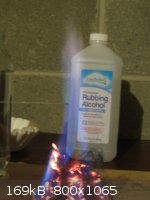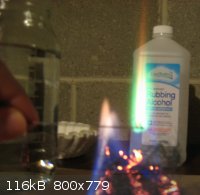White Yeti
National Hazard
   
Posts: 816
Registered: 20-7-2011
Location: Asperger's spectrum
Member Is Offline
Mood: delocalized
|
|
Dehydration of sugar.
I'm posting this in the "beginnings" section because I don't think this is worthy of a full scale discussion.
I wanted to carry out a reaction that requires a small amount of decently pure powdered carbon. Now, obviously charcoal is a very available source of
carbon, but in this case the ash causes a few complications. Long story short, I can't use charcoal.
So I decided to make my own powdered carbon by another method. I dehydrated sugar, which in theory should leave me with a piece of pure porous carbon.
I assumed that this form of carbon would be just like charcoal except that it would not leave any ash residue when burned. Except that this carbon
powder does not burn at all.
It behaves much like graphite, it glows when inserted into a flame, but does not get consumed.
Any ideas as to why this form of carbon behaves this way?
"Ja, Kalzium, das ist alles!" -Otto Loewi
|
|
|
Pulverulescent
National Hazard
   
Posts: 793
Registered: 31-1-2008
Member Is Offline
Mood: Torn between two monikers ─ "hissingnoise" and the present incarnation!
|
|
| Quote: | It behaves much like graphite, it glows when inserted into a flame, but does not get consumed.
Any ideas as to why this form of carbon behaves this way? |
An ordinary flame doesn't have what it takes to ignite pure carbon . . .
"I know not with what weapons World War III will be fought, but World War IV will be fought with sticks and stones"
A Einstein
|
|
|
White Yeti
National Hazard
   
Posts: 816
Registered: 20-7-2011
Location: Asperger's spectrum
Member Is Offline
Mood: delocalized
|
|
I'm using a flame hot enough to light charcoal, I've done it several times as control. The hottest point in the burner I'm using is around 800C, more
than enough to get the job done. There must be another factor.
I'm thinking porosity may be a factor? But even when I crush up the carbon it doesn't burn, it just glows.
"Ja, Kalzium, das ist alles!" -Otto Loewi
|
|
|
Vargouille
Hazard to Others
  
Posts: 380
Registered: 16-4-2012
Member Is Offline
Mood: No Mood
|
|
I don't believe that regular charcoal is pure carbon. It's pretty close, but it could be that whatever it has that makes it not pure carbon allows it
to react at lower temperatures. Could someone else chime in on the specific make-up of charcoal?
|
|
|
barley81
Hazard to Others
  
Posts: 481
Registered: 9-5-2011
Member Is Offline
Mood: No Mood
|
|
Charcoal has an empirical formula close to C<sub>8</sub>H<sub>4</sub>O.
Reference:
http://www.pyroguide.com/index.php?title=Charcoal
|
|
|
mycotheologist
Hazard to Others
  
Posts: 154
Registered: 16-3-2012
Member Is Offline
Mood: No Mood
|
|
What did you use to dehydrate the sugar?
|
|
|
Polverone
Now celebrating 21 years of madness
        
Posts: 3186
Registered: 19-5-2002
Location: The Sunny Pacific Northwest
Member Is Offline
Mood: Waiting for spring
|
|
I believe that the ash-forming salts present in ordinary charcoal have a catalytic effect on the burning. You might compare against charcoal made from
sugar containing 5% sodium carbonate.
PGP Key and corresponding e-mail address
|
|
|
barley81
Hazard to Others
  
Posts: 481
Registered: 9-5-2011
Member Is Offline
Mood: No Mood
|
|
That reminds me of an experiment in which sugar is burned. A sugar cube coated in baking soda burns much more readily than an uncoated sugar cube.
|
|
|
Adas
National Hazard
   
Posts: 711
Registered: 21-9-2011
Location: Slovakia
Member Is Offline
Mood: Sensitive to shock and friction
|
|
Quote: Originally posted by barley81  | | That reminds me of an experiment in which sugar is burned. A sugar cube coated in baking soda burns much more readily than an uncoated sugar cube.
|
This is merely due to fact, that the ash can act as a wick for the molten sugar, IMO.
Rest In Pieces!
|
|
|
Pyro
International Hazard
    
Posts: 1305
Registered: 6-4-2012
Location: Gent, Belgium
Member Is Offline
Mood: No Mood
|
|
i find the best source of carbon is ball milled cokes,
you find cokes almost anywhere, lots of carbon, cheap (free really, just pick up a few lumps at the edge of a pile :p)
all above information is intellectual property of Pyro.  |
|
|
White Yeti
National Hazard
   
Posts: 816
Registered: 20-7-2011
Location: Asperger's spectrum
Member Is Offline
Mood: delocalized
|
|
I thought you'd never ask 

It's an isopropyl alcohol burner, made from the lid of a mason jar and a little steel wool. It produces a clean blue flame as shown, and it is hot
enough to be considered a bunsen burner for all intensive purposes. Here's the spectrum of copper:

The only downside is that sometimes the flame is golden from the presence of iron in the steel wool, but if you're heating stuff up, it doesn't really
matter.
"I believe that the ash-forming salts present in ordinary charcoal have a catalytic effect on the burning. You might compare against charcoal made
from sugar containing 5% sodium carbonate."
I tried dehydrating sugar mixed with a small amount of baking soda and then tried to ignite it. The result was the same, a porous black mass,
impervious to ignition was obtained.
"Ja, Kalzium, das ist alles!" -Otto Loewi
|
|
|